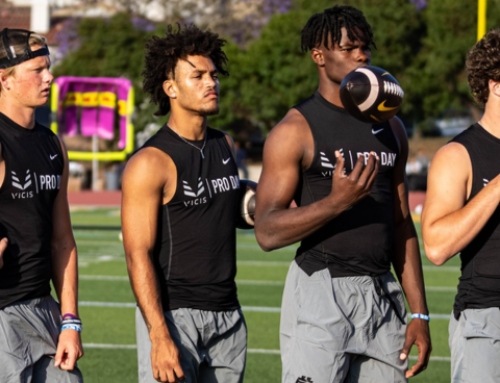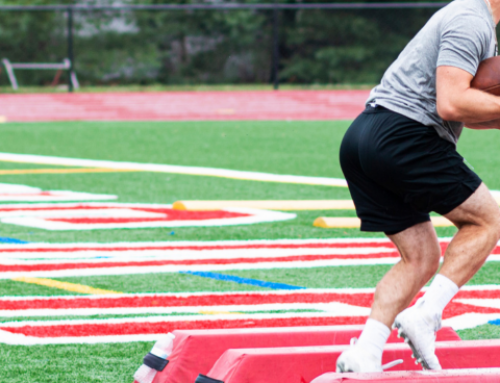At The NFL Combine, The 3-Cone Drill Reveals The Next Great Pass Rusher
For as much as we obsess over the NFL Combine, it cannot predict the future.
A player can have a monster showing and end up a bust, or he can post disappointing numbers and end up an All-Pro. While a strong showing at the Combine is certainly better than a poor one, no one event seems to be particularly predictive of future football success.
However, if you had to pick an event that might “matter most” when it comes to hinting at a player’s future NFL production, you’d be hard-pressed to find a stronger correlation than that between the 3-Cone Drill and elite sack artists.
“(The 3-Cone Drill is) the single most important drill at the combine, plain and simple,” an anonymous NFL Scout told SportsDay Dallas. “I want to know how the player performs in space and this helps show change of direction, explosiveness and overall athleticism. There is validity to this test translating to the football field.”
The 3-Cone Drill was invented in the early 1980s by a legendary scout in the Houston Oilers/Tennessee Titans organization named C.O. Brocato. Also referred to as the L-Drill, the 3-Cone Drill requires athletes to cover a total distance of 30 yards while changing directions six times:
The drill is essentially a series of 5-yard sprints run consecutively, and it requires players to change directions quickly and in a variety of different ways. Moving swiftly and fluidly through the cones is a great measure of body control, agility, balance, ankle mobility and acceleration. All of these are incredibly important attributes for a pass rusher, as they greatly influence an individual’s ability to “bend.”
When used in reference to football pass rushers, “bend” refers to a player’s ability to get underneath and around a blocker while simultaneously curving toward the quarterback’s “spot.” The QB’s spot is where he intends to survey the field from after he takes his drop. If you can get to said spot quickly, that’s guaranteed pressure on the quarterback. Is that final turn on the 3-Cone Drill really so different from how a pass rusher must bend underneath a tackle while fighting to avoid getting washed upfield? No, not particularly.
Sam Hubbard, one of the top defensive end prospects in this year’s draft class, quickly figured out the best way to approach the 3-Cone Drill is by integrating several movements he’s made natural on the football field. “It’s a very important drill for pass rushers to show flexibility and the ability to bend corners,” Hubbard told STACK. “(I’ve been able to improve my time by) just doing what I naturally do on the field, allowing my body to bend like you do when you’re pass rushing. (You’re) just doing it over cones instead. (It’s really about) just letting it go and getting comfortable with it and acting like you’re on the football field and not at a Combine.”
Let’s take a look at how the NFL’s top pass rushers performed in the 3-Cone Drill at the Combine. Thirty-two NFL players have recorded 21 sacks or more over the past three seasons. Of those 32, 21 ran the 3-Cone Drill at the Combine (players often skip events due to injury, and some players weren’t invited to the Combine all together).
Per NFLSavant.com, here are the average 3-Cone Drill times at the Combine for the pass rushing positions:
- Outside Linebacker, 7.1 seconds
- Defensive End, 7.23 seconds
- Defensive Tackle, 7.59 seconds
Now here are the 3-Cone Drill times for each of those aforementioned 21 players, ordered by how many sacks they’ve recorded in the past three seasons:
- Chandler Jones, 7.07 seconds
- Khalil Mack, 7.08 seconds
- Von Miller, 6.70 seconds
- Ryan Kerrigan, 7.18 seconds
- Cameron Jordan, 7.07 seconds
- Aaron Donald, 7.11 seconds
- Melvin Ingram, 6.83 seconds
- Cameron Wake, 7.12 seconds
- Ezekiel Ansah, 7.11 seconds
- Calais Campbell, 7.45 seconds
- Vic Beasley, 6.91 seconds
- Demarcus Lawrence, 7.46 seconds
- Joey Bosa, 6.89 seconds
- Olivier Vernon, 7.39 seconds
- Frank Clark, 7.08 seconds
- Cliff Avril, 6.90 seconds
- Fletcher Cox, 7.07 seconds
- Gerald McCoy, 7.32 seconds
- Nick Perry, 7.25 seconds
- Justin Houston, 6.95 seconds
- Derrick Morgan, 7.12 seconds
Out of all 21 players, just three clocked 3-Cone Drill times slower than their positional average. One of them, Calais Campbell, ran the drill at 282 pounds and often lines up at defensive tackle. He’s a great athlete, but I’m not sure it’s fair to judge him by typical defensive end metrics. But regardless, we’ve got 18 out of the top 21 sack artists in the league with better-than-average showings in the 3-Cone Drill at the Combine. Many of those 18 had outright spectacular times, such as Joey Bosa’s 6.89 or Von Miller’s 6.70. This list also doesn’t include J.J. Watt, who’s been sidelined with injury for much of the past three seasons, but he did record a stellar 6.88 3-Cone Drill at the Combine.
A recent study published in the Journal of Strength and Conditioning Research entitled “Performance of future elite players at the NFL Scouting Combine” found that defensive linemen and linebackers who went on to become Pro Bowl and/or All-Pro players usually ran faster than average in the 3-Cone Drill. This might sound obvious, but it’s not the case for every position—for example, elite NFL quarterbacks and running backs were actually found to clock slower than average 3-Cone Drill times at the Combine.
Does a great time in the 3-Cone Drill guarantee a player will become a terrorizing pass rusher in the NFL? No. But nearly all of the players who do go on to become premier pass rushers have had strong—if not spectacular—showings in the 3-Cone Drill. It’s something to keep in mind as the defensive linemen and linebackers will complete their on-field workouts at the Combine—including the 3-Cone Drill—on March 4.
Photo Credit: Joe Robbins/Getty Images
READ MORE:
RECOMMENDED FOR YOU
MOST POPULAR
At The NFL Combine, The 3-Cone Drill Reveals The Next Great Pass Rusher
For as much as we obsess over the NFL Combine, it cannot predict the future.
A player can have a monster showing and end up a bust, or he can post disappointing numbers and end up an All-Pro. While a strong showing at the Combine is certainly better than a poor one, no one event seems to be particularly predictive of future football success.
However, if you had to pick an event that might “matter most” when it comes to hinting at a player’s future NFL production, you’d be hard-pressed to find a stronger correlation than that between the 3-Cone Drill and elite sack artists.
“(The 3-Cone Drill is) the single most important drill at the combine, plain and simple,” an anonymous NFL Scout told SportsDay Dallas. “I want to know how the player performs in space and this helps show change of direction, explosiveness and overall athleticism. There is validity to this test translating to the football field.”
The 3-Cone Drill was invented in the early 1980s by a legendary scout in the Houston Oilers/Tennessee Titans organization named C.O. Brocato. Also referred to as the L-Drill, the 3-Cone Drill requires athletes to cover a total distance of 30 yards while changing directions six times:
The drill is essentially a series of 5-yard sprints run consecutively, and it requires players to change directions quickly and in a variety of different ways. Moving swiftly and fluidly through the cones is a great measure of body control, agility, balance, ankle mobility and acceleration. All of these are incredibly important attributes for a pass rusher, as they greatly influence an individual’s ability to “bend.”
When used in reference to football pass rushers, “bend” refers to a player’s ability to get underneath and around a blocker while simultaneously curving toward the quarterback’s “spot.” The QB’s spot is where he intends to survey the field from after he takes his drop. If you can get to said spot quickly, that’s guaranteed pressure on the quarterback. Is that final turn on the 3-Cone Drill really so different from how a pass rusher must bend underneath a tackle while fighting to avoid getting washed upfield? No, not particularly.
Sam Hubbard, one of the top defensive end prospects in this year’s draft class, quickly figured out the best way to approach the 3-Cone Drill is by integrating several movements he’s made natural on the football field. “It’s a very important drill for pass rushers to show flexibility and the ability to bend corners,” Hubbard told STACK. “(I’ve been able to improve my time by) just doing what I naturally do on the field, allowing my body to bend like you do when you’re pass rushing. (You’re) just doing it over cones instead. (It’s really about) just letting it go and getting comfortable with it and acting like you’re on the football field and not at a Combine.”
Let’s take a look at how the NFL’s top pass rushers performed in the 3-Cone Drill at the Combine. Thirty-two NFL players have recorded 21 sacks or more over the past three seasons. Of those 32, 21 ran the 3-Cone Drill at the Combine (players often skip events due to injury, and some players weren’t invited to the Combine all together).
Per NFLSavant.com, here are the average 3-Cone Drill times at the Combine for the pass rushing positions:
- Outside Linebacker, 7.1 seconds
- Defensive End, 7.23 seconds
- Defensive Tackle, 7.59 seconds
Now here are the 3-Cone Drill times for each of those aforementioned 21 players, ordered by how many sacks they’ve recorded in the past three seasons:
- Chandler Jones, 7.07 seconds
- Khalil Mack, 7.08 seconds
- Von Miller, 6.70 seconds
- Ryan Kerrigan, 7.18 seconds
- Cameron Jordan, 7.07 seconds
- Aaron Donald, 7.11 seconds
- Melvin Ingram, 6.83 seconds
- Cameron Wake, 7.12 seconds
- Ezekiel Ansah, 7.11 seconds
- Calais Campbell, 7.45 seconds
- Vic Beasley, 6.91 seconds
- Demarcus Lawrence, 7.46 seconds
- Joey Bosa, 6.89 seconds
- Olivier Vernon, 7.39 seconds
- Frank Clark, 7.08 seconds
- Cliff Avril, 6.90 seconds
- Fletcher Cox, 7.07 seconds
- Gerald McCoy, 7.32 seconds
- Nick Perry, 7.25 seconds
- Justin Houston, 6.95 seconds
- Derrick Morgan, 7.12 seconds
Out of all 21 players, just three clocked 3-Cone Drill times slower than their positional average. One of them, Calais Campbell, ran the drill at 282 pounds and often lines up at defensive tackle. He’s a great athlete, but I’m not sure it’s fair to judge him by typical defensive end metrics. But regardless, we’ve got 18 out of the top 21 sack artists in the league with better-than-average showings in the 3-Cone Drill at the Combine. Many of those 18 had outright spectacular times, such as Joey Bosa’s 6.89 or Von Miller’s 6.70. This list also doesn’t include J.J. Watt, who’s been sidelined with injury for much of the past three seasons, but he did record a stellar 6.88 3-Cone Drill at the Combine.
A recent study published in the Journal of Strength and Conditioning Research entitled “Performance of future elite players at the NFL Scouting Combine” found that defensive linemen and linebackers who went on to become Pro Bowl and/or All-Pro players usually ran faster than average in the 3-Cone Drill. This might sound obvious, but it’s not the case for every position—for example, elite NFL quarterbacks and running backs were actually found to clock slower than average 3-Cone Drill times at the Combine.
Does a great time in the 3-Cone Drill guarantee a player will become a terrorizing pass rusher in the NFL? No. But nearly all of the players who do go on to become premier pass rushers have had strong—if not spectacular—showings in the 3-Cone Drill. It’s something to keep in mind as the defensive linemen and linebackers will complete their on-field workouts at the Combine—including the 3-Cone Drill—on March 4.
Photo Credit: Joe Robbins/Getty Images
READ MORE:









